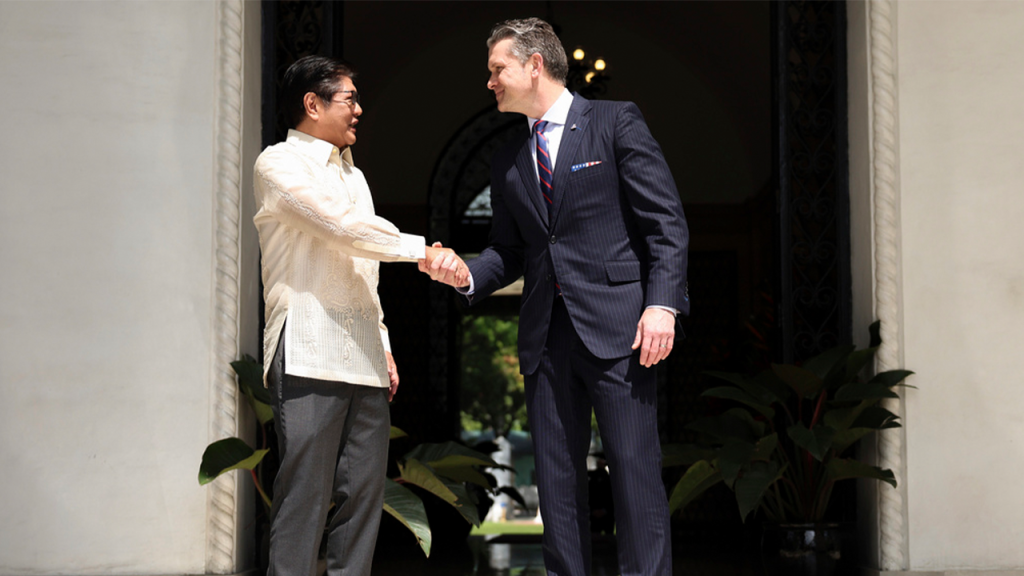U.S. Secretary of Defense Pete Hegseth reaffirmed the commitment to strengthen military relations with the Philippines during a recent meeting with President Ferdinand Marcos Jr.. This strategic discussion aimed at bolstering defense against rising Chinese influence in the contested South China Sea emphasized the importance of allied cooperation. The meeting took place amid increasing tensions in the region, notably escalating encounters between Chinese and Philippine naval forces.
| Article Subheadings |
|---|
| 1) Strengthening Military Ties |
| 2) The Threat of Chinese Aggression |
| 3) A Message of Commitment |
| 4) Upcoming Joint Military Exercises |
| 5) Repercussions and Challenges |
Strengthening Military Ties
During a significant diplomatic visit, U.S. Secretary of Defense Pete Hegseth met with President Ferdinand Marcos Jr. in Manila. The primary focus of their discussions was the enhancement of military cooperation between the United States and the Philippines. Hegseth noted that such collaborations are vital in maintaining regional stability and deterring potential hostilities in key strategic areas, particularly the South China Sea. The Secretary’s words underscored an evolving partnership intended to ensure that both nations can navigate the complexities of modern geopolitics together. This event occurred in the context of a determined effort under the Trump administration to fortify alliances in Asia.
The Threat of Chinese Aggression
China’s assertive territorial claims over the South China Sea pose a vital challenge to regional security. The area is not only significant as a major shipping route but is also rich in resources, making it a focal point of geopolitical tension. Chen has engaged in increasingly aggressive maneuvers, deploying coast guard vessels to assert dominance and confront Philippine ships, which it accuses of encroaching into what Beijing considers its waters. Such incidents have raised alarms about the likelihood of conflicts between naval forces from both nations. Hegseth’s comments reflect a recognition that these challenges necessitate a united front among allies who share common interests in preserving free navigation and security in these contested waters.
A Message of Commitment
The U.S. officials conveyed a strong message of commitment during their discussions. President Ferdinand Marcos Jr. emphasized the significance of Hegseth’s visit as a marker of mutual dedication to preserving peace in the Indo-Pacific region. He noted, “We have always understood that the greatest force for peace in this part of the world would be the United States.” Both leaders reaffirmed their nations’ mutual defense treaty, which obligates the United States to defend the Philippines in times of conflict, thereby underscoring the importance of sustained military cooperation. Hegseth echoed this commitment, stating that it is essential to work together to deter aggression effectively.
Upcoming Joint Military Exercises
Looking ahead, Hegseth’s visit sets the stage for the upcoming joint military exercises that mark the U.S.-Philippines alliance’s largest annual training event. Scheduled to take place in the coming month, these exercises will encompass live-fire drills and various operational scenarios designed to enhance combat readiness. Such collaborations are critical for reinforcing interoperability between the two forces, ensuring they can respond effectively to potential crises. This display of military strength serves both as a deterrent against adversarial actions in the South China Sea and as a testament to the enduring nature of the U.S.-Philippines alliance.
Repercussions and Challenges
While the strengthened military ties signal a robust partnership, challenges persist within the broader geopolitical landscape. The rising influence of China continues to pose questions about the sustainability of such alliances, as tensions remain high in the region. Furthermore, on the home front, Hegseth faces increasing scrutiny regarding his management of sensitive military communications, which may have implications for his future role within the defense establishment. The criticisms highlight that while international alliances are necessary for regional stability, domestic policies and workforce integrity also deserve careful management.
| No. | Key Points |
|---|---|
| 1 | U.S. Secretary of Defense Pete Hegseth emphasized enhanced military ties with the Philippines amid rising tensions in the South China Sea. |
| 2 | China’s territorial claims have led to aggressive confrontations with Philippine forces, raising regional security concerns. |
| 3 | The U.S.-Philippines Mutual Defense Treaty was reaffirmed as a key framework for collaboration against potential threats. |
| 4 | Upcoming joint military exercises are aimed at improving combat readiness and showcasing the alliance’s strength. |
| 5 | Domestic pressures concerning military communication practices are also a topic of concern for Hegseth’s tenure as Secretary of Defense. |
Summary
The meeting between U.S. Secretary of Defense Pete Hegseth and Philippine President Ferdinand Marcos Jr. symbolizes a growing collaboration between the two nations in the face of Chinese aggression in the South China Sea. The discussions not only strengthened commitments to mutual defense but also set the stage for upcoming military exercises that will showcase their partnership. As tensions in the region continue to rise, these efforts reflect a strategic understanding of the challenges posed by adversaries while maintaining a focus on the principles of peace through strength.
Frequently Asked Questions
Question: What prompted Secretary Hegseth’s visit to the Philippines?
Secretary Hegseth’s visit was aimed at strengthening military ties amid rising tensions in the South China Sea due to increasing Chinese aggression.
Question: How do the U.S. and Philippines strengthen their military relationship?
The U.S. and the Philippines strengthen their military relationship through joint exercises, reaffirming mutual defense commitments, and enhancing operational readiness in response to regional threats.
Question: What are the upcoming military exercises between the U.S. and the Philippines focused on?
The upcoming military exercises will include live-fire drills and operational training to improve interoperability and combat readiness among the forces of both nations.


